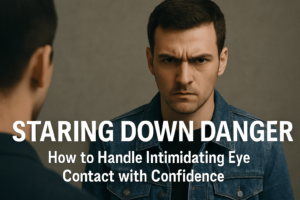
Understanding the Dynamics of Size in Self-Defense
When faced with a larger attacker, the dynamics of self-defense change significantly. Larger attackers typically have advantages in reach, strength, and possibly weight. However, these advantages can be mitigated with the right strategies and techniques. Understanding your attacker and preparing mentally and physically can transform what seems like an insurmountable challenge into a manageable situation.
Psychological Preparation and Mindset
The psychological aspect of self-defense is paramount. Confidence, awareness, and mental fortitude can significantly impact the outcome of an altercation. Believing in your ability to defend yourself is the first step. Visualize successful defenses and maintain a calm, focused demeanor. Panic can lead to mistakes, while calmness can open pathways to effective self-defense.
Building Confidence Through Training
Training consistently in self-defense techniques boosts confidence. Regular practice helps develop muscle memory and improves reaction times, making you more capable of handling stressful situations. Martial arts such as Brazilian Jiu-Jitsu, Krav Maga, and Muay Thai focus on techniques that leverage an opponent’s size and strength against them.
Leveraging Technique Over Strength
Targeting Vulnerable Points
Regardless of size, all human bodies have vulnerable points. Targeting these points can help neutralize a larger attacker. Aim for the eyes, nose, throat, groin, and knees. Strikes to these areas can cause significant pain and disorientation, giving you the chance to escape or gain the upper hand.
Eyes
Strikes or gouges to the eyes can temporarily blind your attacker. This can be achieved with finger jabs, palm strikes, or any object within reach.
Nose
A well-placed palm strike or elbow to the nose can cause intense pain and watering eyes, making it difficult for the attacker to focus.
Throat
Strikes to the throat can disrupt breathing and cause significant pain. Use chops, punches, or elbow strikes to this sensitive area.
Groin
A kick or knee to the groin can incapacitate an attacker momentarily. This is especially effective as it exploits a universally sensitive area.
Knees
Kicking the knees can destabilize an attacker, making it difficult for them to stand or pursue you. Use low, powerful kicks to the sides or back of the knee.
Using Leverage and Momentum
Leverage and momentum are critical in overcoming size disadvantages. Techniques that involve using an attacker’s weight and movement against them can be incredibly effective. Throws, joint locks, and sweeps are designed to exploit these principles.
Throws and Sweeps
Techniques such as hip throws, leg sweeps, and shoulder throws can unbalance a larger opponent. Training in martial arts like Judo or Jiu-Jitsu provides invaluable skills in these areas.
Joint Locks and Holds
Joint locks can immobilize an attacker, giving you control. Techniques like arm bars, wrist locks, and shoulder locks use minimal strength but can cause intense pain and incapacitation.
Environmental Awareness and Utilization
Using Your Surroundings
The environment can be a powerful ally in self-defense. Look for objects that can be used as weapons or shields. Chairs, pens, keys, or even dirt can become tools for protection. Strategically positioning yourself can also aid defense; try to keep obstacles between you and the attacker to limit their movement and reach.
Escape Routes
Awareness of escape routes is crucial. Identify exits and obstacles that can slow down your attacker. The primary goal in self-defense is not to engage but to escape safely. Use the environment to create opportunities for a swift retreat.
Physical Conditioning and Preparedness
Strength and Endurance Training
While technique trumps brute strength, being in good physical condition can improve your ability to execute techniques effectively. Strength training, cardiovascular exercises, and flexibility routines enhance your overall physical readiness.
Drills and Simulations
Regular practice through drills and simulations can mimic real-life scenarios, preparing you for various situations. Partner drills in controlled environments help refine techniques and build confidence in your ability to execute them under pressure.
Legal and Ethical Considerations
Understanding Your Rights
Self-defense laws vary widely, but it’s essential to understand the legal ramifications of your actions. Knowing your rights and the legal definition of self-defense in your jurisdiction ensures that you can protect yourself without facing legal consequences.
Proportionality and Necessity
In self-defense, the use of force must be proportional to the threat. Excessive force can lead to legal issues. Aim to neutralize the threat with minimal necessary force, prioritizing escape and de-escalation whenever possible.
Conclusion: Empowerment Through Knowledge and Training
Self-defense against a larger attacker requires a combination of psychological readiness, effective techniques, environmental awareness, and physical conditioning. By targeting vulnerable points, leveraging momentum, and utilizing the environment, you can defend yourself effectively. Continuous training and mental preparation are key to developing the confidence and skills necessary to protect yourself in any situation.



















